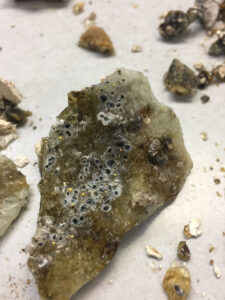Times Square’s normal bustle is quieter as New Yorkers adhere to quarantine, but it still holds a touch of magic. A passerby of “ZAZ Corner,” a digital gallery that showcases artwork on a huge LED screen, will see what looks a deluge of golden sparks. A closer look reveals gold coins dissolving in a solution known as aqua regia. University of Utah metallurgical engineering assistant professor York Smith facilitated the science behind the art.
“It’s interesting timing, it’s quite poetic. A video showing a gold coin dissolving amidst all of this economic collapse,” said Smith.
The video is part of a larger exhibition called “Reverse Alchemy” by New York-based artist Jessica Segall. Her concept was to return gold back into the ecosystems from which it is usually extracted. The Peruvian government funded the project, which debuted as part of an exhibition honoring Peruvian weaver, farmer and activist, Máxima Acuña, at the ICPNA in Lima, Peru, in January and February 2020.
Several of the “Reverse Alchemy” segments centered around reintroducing gold into the land near the Conga Mine, a controversial gold and copper project that attempted to seize agricultural land in the Cajamarca Region in northern Peru. One performance video features Acuña, who won the Goldman Environmental Prize for her peaceful protests against the mine to stay on her land and expose its threat the region’s water. The protests successfully shut down the mine in 2016.
Smith was involved in a piece that put gold back into a rock-like form from Conga Mine samples. Segall needed someone to help figure out how to work with the metal. After googling metallurgical engineering programs, she found Smith and cold-emailed a pitch to him. Smith has collaborated with artists before on various multidisciplinary, industrial-scale projects. Seagall’s proposal piqued his interest.
“It’s completely impractical. We’ve spent millennia trying to get gold out of rocks. I’m extremely interested,” he recalled saying.

For six weeks, Segall and Smith brainstormed how to translate the artistic concept into something scientifically feasible and aesthetic. Once they had a plan, she flew out to Smith’s lab in the Department of Materials Sciences and spent three days executing and filming the process.
Smith was inspired by the natural thermodynamic processes that form gold ore, the raw material from which mines extract the pure gold metal. The Times Square video segment “Reverse Alchemy in Conga (Aqua Regia)” was the first step—dissolving nearly-pure gold coins in a solution of hydrochloric and nitric acid, called aqua regia.
A coin sits at the bottom of a beaker and bubbles start to form. Over time, the solution gets progressively darker as the gold dissolves into the liquid mixture, similar to how salt dissolves into boiling water, Smith explained.
They then coaxed the pure gold particles to precipitate out of solution into a solid, metal powder. They ground up the Conga Mine rocks, added some glass and other minerals, and made a mold from foundry sand. Like a geologic bakery, they combined all materials, heated it up for a long time. As it cooled, a rock began to solidify as all of the elements incorporated together.
The experience inspired Smith to think differently about his own research. One of his lab’s projects is to extract lithium from brine out of the Great Salt Lake, a chemical essential to many industries, from electronics to air purification.
“At first, this project seemed ridiculous,” he said, “but it got me thinking about our research and looking at it from a different point of view.”
– Lisa Potter,